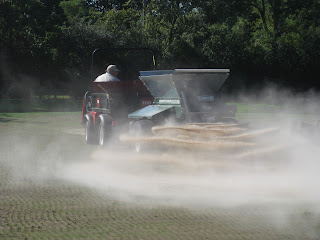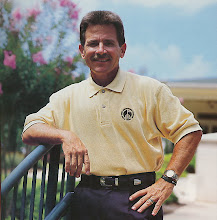My family and I would like to wish each of you and your families and loved ones a safe, blessed and joyous holiday season. I hope you have the time and opportunity to share with your family and friends and those who are in need of our company at this special time of the year. Best wishes to all.
Thursday, December 15, 2011
Tuesday, December 6, 2011
New Tee #2 Red
Dr. Hurdzan agreed that a forward tee on #2 red would be a positive addition. Therefore, we have just completed the construction of a new tee on #2 red. The tee is located between the existing men's tee and the ladies tee. This will be a white tee location. I think those of you who play the white tees will find it very friendly and enjoyable.
The area before the new tee
Rootzone mix was hauled in for the top of the tee.
Rootzone mix is leveled for the top of the tee.
In-house staff lays sod around the new tee
Quite a cold day for laying sod
Quite a cold day for laying sod
Sod for the top of the tee will be laid in the spring
Another project completed by a great NCC staff.
These guys are very talented and do a great job.
Wednesday, October 19, 2011
Why do you put sand on the fairways?
Over the last 4 or 5 years we have implemented a topdressing program following aerificaiton on the fairways. In this process, sand is applied to the fairways for the main purpose of controlling thatch. I have included a description and photos of what excessive thatch is and how it can negatively affect turfgrass quality and playing conditions. An additional benefit to a regular fairway topdressing program is that it assists in creating a drier surface on the turf so that carts can get out on the fairways sooner following a rainfall.

Sand topdressing is then applied to the turf.

Thatch is a layer of living and dead organic matter that occurs between the green matter and the soil surface. Excessive thatch (over 1/2 inch thick) creates a favorable environment for pests and disease, an unfavorable growing environment for grass roots, and can interfere with quality golfing conditions.
The primary component of thatch is turfgrass stems and roots. It accumulates as these plant parts buildup faster than they breakdown. Thatch problems are due to a combination of biological, cultural, and environmental factors. Cultural practices can have a big impact on thatch. As thatch levels accumulate to greater than 1/2 inch, turf problems may begin, and the thatch needs to be controlled. .
Below, once again you can see the thatch layer between the bottom of the turf and the gray colored soil. The area is dense and tangled and attracts insects and is a haven for disease occurrence. In dry periods this layer keeps water from getting deeper into the soil and to the roots where the plants can utilize the water. During wet periods the thatch acts like a sponge and hold water reducing the ability for the turf to drain.
The soil probe photo below shows another of undesirable and excessive thatch in a turf.Fairway aerification is implemented to reduce thatch and have firmer and drier turf surfaces
Aerification plugs are "chopped-up"
The tufts of grass left from the aerificaiton & the chopping process are blown together for collection & removal
Sand topdressing is then applied to the turf.
A brush or steel drag mat is then used to drag the sand into the aerification which aides in providing channels for better surface drainage and oxygen exchange to the roots as well as reducing thatch levels.
How does thatch affect turf quality?
An excessive thatch layer (more than 1 inch) can restrict the movement of air, water, fertilizer and other materials to the roots. This air- and water-impervious layer causes the grass to restrict rooting to the thatch layer which in turn reduces drought resistance in the turf. Additionally, if the thatch dries out, it becomes very difficult to re-wet with out the use of wetting agents or mechanical manipulation.
An excessive thatch layer (more than 1 inch) can restrict the movement of air, water, fertilizer and other materials to the roots. This air- and water-impervious layer causes the grass to restrict rooting to the thatch layer which in turn reduces drought resistance in the turf. Additionally, if the thatch dries out, it becomes very difficult to re-wet with out the use of wetting agents or mechanical manipulation.
Tuesday, October 11, 2011
What factors influence the seasonal opening and closing of the range tee?
The NCC driving range is a busy place. It receives more activity than any private club driving range that I have ever seen. Thousands of ball are hit each day. In order for the surface to be ready for spring play, it is necessary to give it the attention it needs in the fall while the growing conditions are still favorable for recovery.
It wasn't long ago that the driving range tee was in poor condition on a year round basis (see photo below.)Despite enlarging the range grass tee by 2.5 times in size, we still rotate through the range tee 3 or 4 times a year. Many clubs do not even go through their full range tee once or even twice in a year. Unlimited ball access, active lesson schedules and just plain ole practice impact the range turf at NCC.
If we want quality hitting conditions as witnessed below in the spring when the course opens then there are early fall measures that must be taken to prepare the grass tee and the short game hitting area.
The photos below are examples of the extensive divots and wear on the range tee and short game approach turf. These areas must be seeded and topdressed and leveled while the weather is still warm enough to germinate the seed and have it fill-in before the frosts of the fall and ice of the winter impacts it.
Without closing the range tee in October for re-seeding then this is how some of the areas would look when we open the course in the spring. Grass does not grow in the winter months under the snow.
Divots in the short game area must be re-seeded and allowed to germinate while the weather permits.
Saturday, September 24, 2011
Aerification Video
The following site provides a video on the reasons for aerificaiton. I think you will like it.
http://www.youtube.com/watch?v=va98sIUEjFw
http://www.youtube.com/watch?v=va98sIUEjFw
Friday, September 16, 2011
Aerification Process
Aerification will begin on the greens and fairways next Monday the 19th. The photos below show the aerificaiton and clean-up process that we employ on the greens.
The greens are aerified
The soil plugs are brushed and shoveled into wind rows for collection
The grass and soil plugs are wind-rowed
The greens are then topdressed with sand to fill in the aerificaiton holes The sand is worked into the aerification holes via the use of a turf brush
At times the topdressing sand is hand brushed into the holes
The holes are filled to the top with sand
The greens are rolled to make them smooth Finally, the greens are mowed
The greens will always be slower following aerification because of the holes and the fact that the topdressing sand immediately dulls the mowers. It takes a week or so for the sand to totally work down into the turf canopy. The mowers are sharpened and the speed begins to return to the putting surfaces.
Wednesday, September 14, 2011
Anniversary
Today Lorrie and I celebrate our 26th anniversary. I am blessed to have such a loving and healthy family (Seth , Lauren & Tanner.) What is more important than family, heath, friends and faith?
Wednesday, September 7, 2011
Texas Fires
I realize this is not a golf course related news item but it is an important issue.
These are the wildfires in the Austin, Texas area that are close to my home and family. Over 1000 homes have already been destroyed. This part of Texas is in a 3 to 4 year stage 2 drought. The dry conditions make it difficult to contain the fires.
Tuesday, August 30, 2011
Attention Golfers
I have included a number of photos below that depict areas where NCC members and their guests can significantly assist in contributing to tremendous golfing conditions at NCC. These are actually simple tasks that are common golf course etiquette and that every golfer should be practicing.
We spend over $50,000 a year in repairing ball marks, fairway and tee divots and worn areas along the cart paths from poor cart operation. Please do your part to help care for our fantastic property.
The photo below shows the WRONG way to park a golf cart along the cart path. There is no reason to pull over and off of the path. Your playing partners can and should park behind you. We spend over $10,000 a year correcting these bare "eyesores."
The photo below shows the correct way to park a cart around a tee or green. Keep all 4 tires on the path.
Unrepaired ball marks are currently the only blemishes on our otherwise wonderful putting surfaces.
An unrepaired ball mark will take 3 to 4 weeks to heal. It is not only unsightly but can affect other golfers putting ability.
The golfer who hit the fairway shot below made no attempt to repair the divot. This neglect should not be part of the NCC golfing culture.
It is extremely dangerous to have more than 2 riders on a cart.
Please observe the yellow lines and the stop areas at the two gates South of Clavey Road.
Please place your trash in the trash receptacles rather than on the ground.
Subscribe to:
Posts (Atom)























